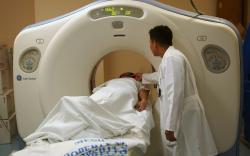Press Releases

Our study reflects the success of national, state, and local anti-tobacco public health policies and activities in the Black community despite the tobacco companies’ targeted and deceptive marketing strategies
A trend of higher lung cancer incidence rates in young Black people versus young white people in the United States has flipped, with the Black/white gap disappearing in men and reversing in women. The changing trends coincide with steeper declines in smoking in Black Americans, according to a new study, which appears in JNCI Cancer Spectrum.
Lung cancer is the leading cause of cancer death in the United States, with about 80% of the total 154,000 deaths recorded each year caused by cigarette smoking. Historically, lung cancer incidence rates have been higher in non-Hispanic Black people than non-Hispanic white people among men of all ages and among younger women, likely reflecting historically higher smoking rates in Black adults.
For the new study, American Cancer Society investigators led by Ahmedin Jemal DVM, PhD, examined smoking prevalence data and national lung cancer incidence rates for Black and white people by sex among contemporary young birth cohorts, to investigate whether incidence patterns are consistent with race- and sex-specific smoking patterns.
They found incidence decreased in both Black and white men born since about 1947 and in women born since about 1957, with the declines steeper in Black people than white people. Those steeper declines led to the Black/white gap disappearing in men born in 1967 to 1972 and reversing in women born since about 1967. Similarly, historically higher smoking rates in Black people versus white people disappeared in men and reversed in women born since about 1965.
There was one notable exception. The authors identified increasing lung cancer incidence rates in Black men born around 1977-1982, which indeed led to higher lung cancer incidence rates in Black than white men born during this period. “This increase likely reflects the steep rise in initiation of smoking among Black adolescents in 1990s, which coincided with the R.J. Reynold’s tobacco advertisement campaign targeting African Americans,” write the authors. “Between 1991 and 1997, the prevalence of current cigarette use among Black high school students doubled from 14.1% to 28.2%.”
The authors say that their findings have significant public health implications. “Our study reflects the success of national, state, and local anti-tobacco public health policies and activities in the Black community despite the tobacco companies’ targeted and deceptive marketing strategies,” said Dr. Jemal. “At the same time, the increase in lung cancer incidence among Black men born around 1982 reflects the lack of strong public health policies to prevent the rise in smoking initiation in 1990s.”
“While these patterns herald progress in reducing racial disparities in lung cancer occurrence and the success of tobacco control in the Black community, the increasing lung cancer incidence rates in Black men born circa 1977-1982 is concerning and underscores the need for targeted tobacco prevention interventions,” the authors conclude.
Article: Jemal A, Miller KD, Goding Sauer A, Bandi P, Fidler-Benaoudia MM, Culp M, Islami F, Fedewa SA, Ma J. Changes in Black-White difference in lung cancer incidence among young adults. JNCI Cancer Spectrum 2020 DOI 10.1093/jncics/pkaa055